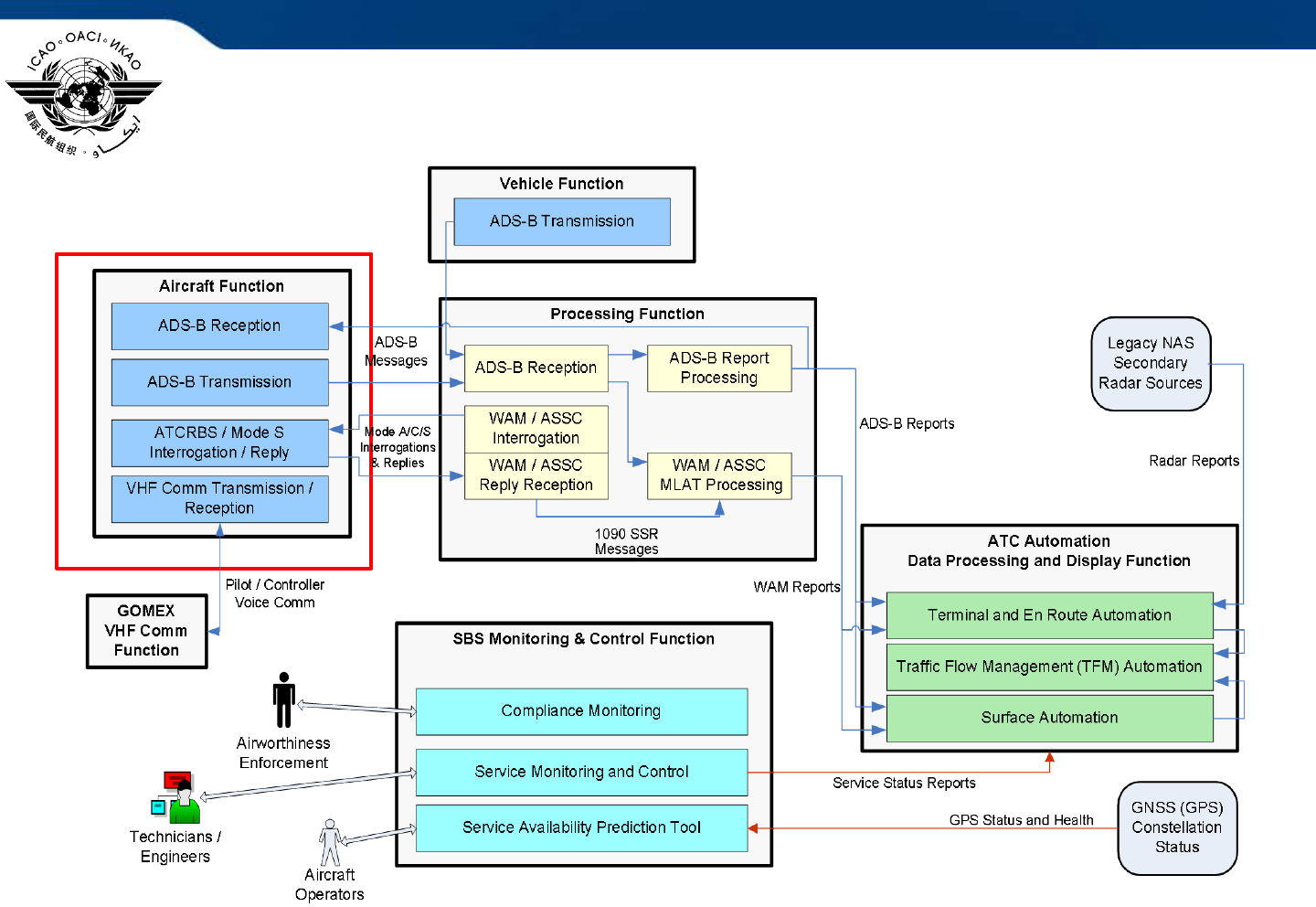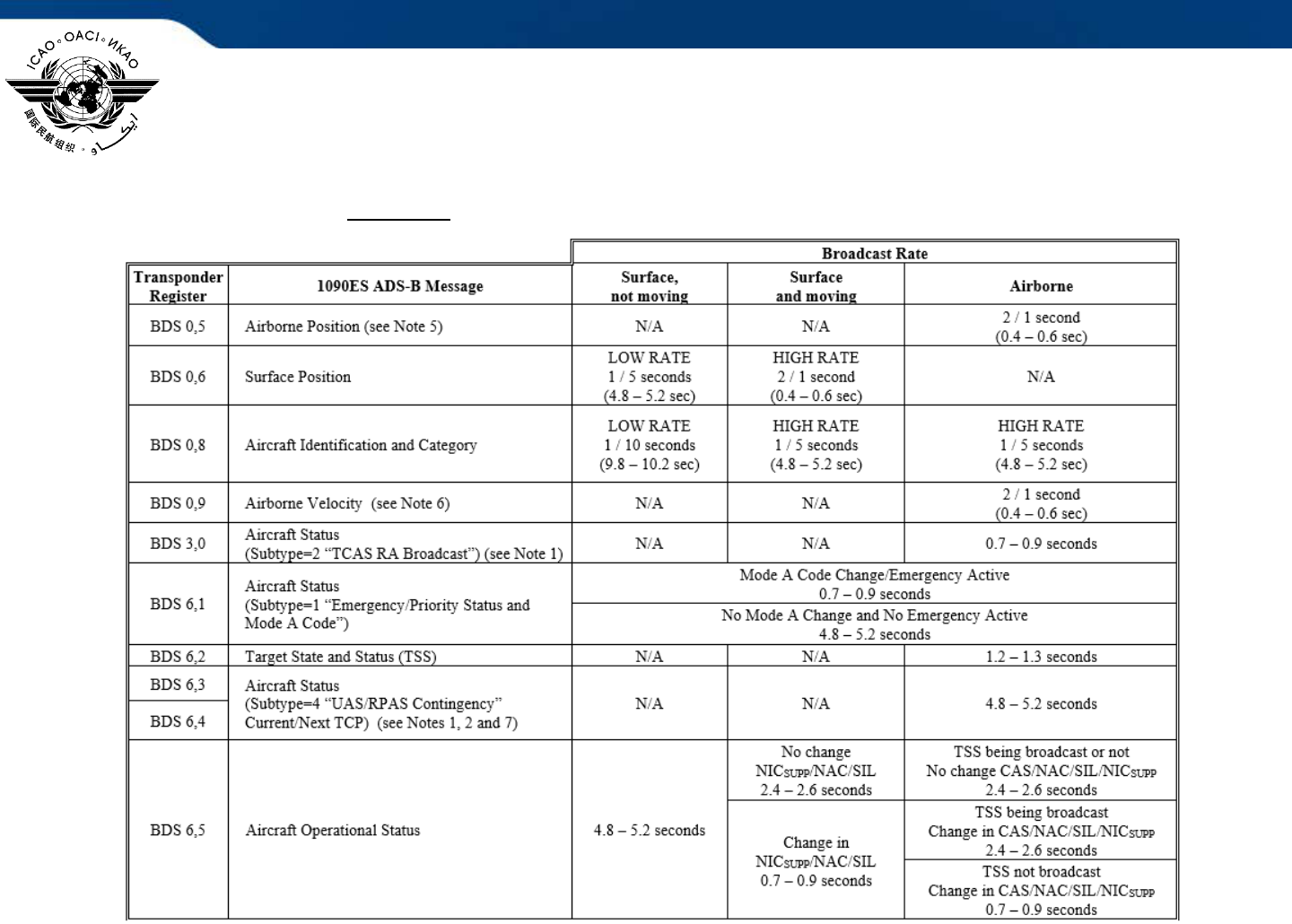
International Civil Aviation Organization
Overview of Automatic Dependent
Surveillance-Broadcast (ADS-B) Out

Module Objectives
• Definition of ADS-B
• Overview of ADS-B OUT
• ADS-B Messages
• Aircraft Systems
• ADS-B Performance and Compliance

Automatic Dependent Surveillance - Broadcast
(ADS-B)
• Automatic
Periodically transmits information with no pilot
or operator involvement required
• Dependent
Position and velocity vectors are derived from
the Global Positioning System (GPS) or other
suitable Navigation System (i.e., FMS)
• Surveillance -
A method of determining 3 dimensional
position and identification of aircraft, vehicles,
or other assets
• Broadcast
Transmitted information available to anyone
with the appropriate receiving equipment
• Satellite-based Cooperative Surveillance Technology
• Allows pilots and controllers to have a common picture of airspace
• Allows for common situational awareness to all equipped users of the airspace

FAA Surveillance Functional Architecture

ADS-B “OUT”
ADS-B
Station
GPS position
GPS position
GNSS Satellite
constellation
(multi-sensor)
Surveillance Data Processing
ADS-B transmissions
ATC
Center

ADS-B “IN” Overview
ADS-B
Station
GPS position
GPS position
GNSS Satellite constellation
(multi-sensor)
Surveillance Data Processing
ADS-B transmissions
ATC
Center
ADS-B data from certified
1090ES transponder
ADS-B “out” ADS-B “in”
Requires in the aircraft:
ADS-B receiver
ADS-B data processing
Cockpit Display
ATCO remains responsible for
separation

ADS-B Components
ADS-B OUT - airborne
• Mode S Transponder
• Extended Squitter enabled
ADS-B OUT - receiver
• Antenna + Receiver
• Adapted Surveillance
Processor

FAA ADS-B Receiver Systems

ADS-B Technologies
• 1090 MHz Extended Squitter (1090ES)
– Implemented widely on commercial traffic
– Initial carriage facilitated by European Mode S mandate and
the FAA ADS-B OUT Final Rule publications
– 1090 MHz Extended Squitter is the preferred International link
• UAT
– UAT = Universal Access Transceiver at 978 MHz
– Used in USA (mainly for General Aviation aircraft)
– Regional implementations
• VDL Mode 4
– VDL = VHF Digital Link, Mode 4
– Regional implementation
* It is important to note that 1090 MHz is the internationally approved
frequency

ADS-B Out Messages
• The ADS-B Out equipment is designed to transmit two different message
sets:
– “Short Squitter” (also known as the Mode S Acquisition Squitter)
– Extended Squitter
• Acquisition squitters include minimal information and allow systems on
other aircraft (e.g., ACAS) to acquire a target without the need to
interrogate.
• Extended squitters provide additional information based on the Minimum
Operational Performance Standards (MOPS) that the avionics system is
designed to:
– DO-260 (Version 0)
– DO-260A (Version 1)
– DO-260B (Version 2)
– DO-260C (Version 3), approved December 2020

Acquisition Squitter
• The Mode S transponder outputs an unsolicited transmission once per
second to enable ACAS to acquire Mode S equipped aircraft
– carries only the ICAO 24 bit a/c address, which is a unique aircraft
identifier used in Mode S
TRANSMITTED ONCE PER SECOND
MODE S SHORT SQUITTER (56 BITS)
8 bit
CONTROL
24 bit
A/C ADDRESS
24 bit
PARITY

ACAS X Overview
• ACAS X is a family of next generation aircraft collision
avoidance systems.
– Backward / forward compatible
– ACAS Xa and Xo MOPS have been published (RTCA DO-385 MOPS)
• Provides the same general role as TCAS II:
– Surveillance of nearby aircraft
– Generation of Traffic Advisory/Resolution Advisory
– Coordination with other aircraft collision avoidance systems
• Supports New Capabilities:
– Leverages Additional Surveillance Sources (e.g., ADS-B)
– Intended for multiple types of host aircraft (commercial, general
aviation, rotorcraft, UAS)

Use of 1090ES for Surveillance
* Requires hardware that can receive and decode 1090ES DF17 messages

1090ES Message Format
EXTENDED (112 BIT) SQUITTER
GNSS
GNSS
GNSS
EXTENDED SQUITTER
GROUND STATION
TO ATC
FACILITY
24 bit
PARITY
56 bit
ADS MESSAGE
8 bit
CONTROL
24 bit
A/C ADDRESS
1090ES includes a 56 bit data field
used to carry ADS-B information
ADS-B information is
derived from the onboard
avionics navigation
systems

BDS Registers
• BDS Registers are specified in ICAO Doc 9871, Edition 2,
and the Mode S SARPs
– BDS registers are also referred to as GICB registers
because they can be downlinked via “Ground Initiated
Comm B transactions”
• Each register contains the data payload of a particular
Mode S reply or extended squitter
• Registers not updated within a fixed period are cleared by
the transponder
• Registers are identified by a two digit hex number
– for example BDS 05h or BDS 0,5 is the position squitter
• Certain BDS registers refer specifically to 1090ES

BDS Registers in ED-102A/DO-260B
Broadcast Rate
Transponder
Register
Event-Driven
Message Priority
1090ES ADS-B Message
On-the-Ground,
not moving
On-the-Ground
and moving
Airborne
BDS 0,5 N/A
Airborne Position
N/A N/A
2 / 1 second
(0.4 – 0.6 sec)
BDS 0,6 N/A
Surface Position
LOW RATE
1 / 5 seconds
(4.8 – 5.2 sec)
HIGH RATE
2 / 1 second
(0.4 – 0.6 sec)
N/A
BDS 0,8 N/A
Aircraft Identification and Category
LOW RATE
1 / 10 seconds
(9.8 – 10.2 sec)
HIGH RATE
1 / 5 seconds
(4.8 – 5.2 sec)
HIGH RATE
1 / 5 seconds
(4.8 – 5.2 sec)
BDS 0,9 N/A
Airborne Velocity
N/A N/A
2 / 1 second
(0.4 – 0.6 sec)
BDS 6,1
TCAS RA = 1
Emergency = 2
Aircraft Status
(Emergency/Priority Status, Subtype=1)
(TCAS RA Broadcast, Subtype=2)
TCAS RA or Mode A Code Change
0.7 – 0.9 seconds
No TCAS RA, No Mode A Change
4.8 – 5.2 seconds
No TCAS RA, No Mode A Change, No Emergency, Mode A Code set to 1000
8
No Transmission
BDS 6,2 N/A
Target State and Status (TSS)
N/A N/A 1.2 – 1.3 seconds
BDS 6,5 N/A
Aircraft Operational Status
4.8 – 5.2 seconds
No change NIC
SUPP
/NAC/SIL
2.4 – 2.6 seconds
TSS being broadcast or not
No change
TCAS/NAC/SIL/NIC
SUPP
2.4 – 2.6 seconds
Change in NIC
SUPP
/NAC/SIL
0.7 – 0.9 seconds
TSS being broadcast
Change in
TCAS/NAC/SIL/NIC
SUPP
2.4 – 2.6 seconds
TSS not broadcast
2
Change in
TCAS/NAC/SIL/NIC
SUPP
0.7 – 0.9 seconds
Table 2-79: 1090 MHz Extended Squitter ADS-B Message Broadcast Rates
N/A = Not Applicable

BDS Registers in ED-102B/DO-260C
Table 2-79: 1090 MHz Extended Squitter ADS-B Message Broadcast Rates
N/A = Not Applicable

BDS Registers in ED-102B/DO-260C
Table 2-79: 1090 MHz Extended Squitter ADS-B Message Broadcast Rates
N/A = Not Applicable


• In order to populate each of the messages, the ADS-B device relies on
other aircraft systems
• The following is an example of some of the avionics systems providing
information to the ADS-B avionics
Aircraft Systems
GNSS Satellite

Aircraft Equipage
• Aircraft equipage is a key element that the Civil Aviation
Authority (CAA) and Air Navigation Service Providers
(ANSPs) must consider
• The type of ADS-B implementation may drive additional
considerations on the type of equipage required in order
to ensure proper aircraft detection
• For example:
– ground system implementations may be satisfied with a
bottom only antenna
– Space Based implementation would require aircraft to have
an antenna visible to the satellites

Quality Indicators
• Quality Indicators are used by the ATC Processing
System to determine
– whether ADS-B Surveillance reports (and therefore the
derived target position) can be used to support the various
functions in the provision of Air Traffic Services,
and in particular,
– whether the defined ATC Surveillance Separation standard
can be supported
• These indicators are either calculated by the ADS-B
device (e.g., NIC/NUCp) or configured at installation (e.g.,
SIL, SDA, Length/Width Code)

Navigation Integrity Category (NIC)
• The Navigation Integrity Category (NIC) is calculated solely based on the
containment radius
• This value in combination with the NIC Supplement A & B determines the
Type Code to be transmitted in the Airborne Position Message

NUCp to NIC Conversion
Airborne Position

ADS-B Position Message
Surface Position

Monitoring of Regulatory Compliance
• FAA* uses a tool called the ADS-B Performance Monitor
(APM) to detect:
• Non-Equipped operations in ADS-B Out required
airspace
– Including improperly equipped aircraft (e.g., Version 0 or
Version 1)
• Improper ADS-B Operation
– Equipment must be on at all times
• Subject to revised 91.225 (f)
– Proper procedures for pilot entered data (e.g., Flight ID)
• Call Sign Mis-Match (CSMM)
• Non-performing equipment (NPE)
– Airworthiness issues, monitored by FAA Flight Standards
*Inspectors from aircraft Maintenance and Flight Technologies and Procedures Divisions in the Office of Safety Standards

Monitoring of Regulatory Compliance
• In order to identify NPE’s, the APM leverages the
ADS-B Out information to identify aircraft operating
in U.S. airspace that are not meeting the
performance standards specified in 14 CFR 91.227.
– Checks integrity and accuracy of position information
• Compliant NIC, NACp, NACv, SIL, SDA
– Checks for required message elements
• Lat/Long, Velocity, Baro & Geo Altitude, Mode 3/A, Flight ID, proper
ICAO 24-bit address, Emitter Category, Length/Width code, etc.
– Performs validity checks (Kinematics) on position, velocity,
altitude

ADS-B Performance Monitor

ADS-B Performance Monitor

Monitoring of Regulatory Compliance
• When the FAA learns of a suspected violation, via the APM or
any other means, the following is initiated:
– Relevant information is sent to an investigating office (e.g., Flight
Standards District Office (FSDO), Certificate Management Office
(CMO), or International Field Office (IFO))
• If detected by APM, information will be sent from the Aircraft Maintenance
Division or Flight Procedures and Technologies Division
– Responsible FAA office conducts investigation following
procedures established in FAA Orders 8900.1 and 2150.3C
• After the investigation occurs, the responsible FAA office
takes appropriate actions to address the apparent violations
– Compliance, administrative, or legal enforcement actions, in
accordance with established policy

FAA Surveillance Functional Architecture
